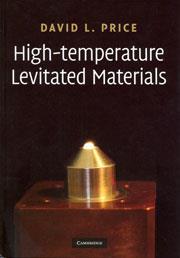High temperature levitated materials
High temperature levitated materials
David Price
Cambridge, UK: Cambridge University Press 2010 | 240pp | ?70.00 (HB)
ISBN 9780521880527
Reviewed by Martin Wilding

The liquid state dominates physical, chemical and biological processes yet remains poorly understood. Levitation of liquids is proving to be invaluable for liquid state studies and this well-presented, and easy to read monograph, provides an excellent introduction to these containerless techniques. This book is an excellent resource. Graduate students, post-docs and academics will find a wealth of information, presented in a logical and systematic manner. It should be viewed as essential reading for all interested in high temperature liquid structure. A strength of this book is that it is driven by the science; a need to understand the liquid state and the processes of vitrification and crystallisation. As such, this monograph serves several purposes; it is not only a superb introduction to the use of levitation techniques but also provides an excellent introduction to the systems worthy of study and a discussion of the experimental techniques that can be used in combination with levitation.
The text follows a natural progression through the development and evolution of levitation techniques and methods. Conical nozzle levitation, electrostatic levitation and electromagnetic levitation, probably the three currently most popular techniques, are discussed in detail. These form part of sample environment armoury available at third generation synchrotron x-ray sources. However, other levitation methods are also discussed and there is enough to intrigue those interested in lower temperature liquids and to suggest new opportunities for the study of the liquid state.
Diffraction of levitated liquids, especially diffraction using high energy x-rays, is an increasingly popular method of exploring liquids, including the metastable supercooled regime. There are a wealth of other techniques also available, and in this volume there is an excellent summary of methods that can be used to evaluate optical and electromagnetic properties, thermophysical properties, small angle scattering, x-ray absorption, NMR and, perhaps the most challenging of all, inelastic x-ray scattering. Each technique receives a brief introduction and a discussion of the pioneering experiments that have been performed. This will be an important first reference point for student and experienced researcher alike and this excellent and well-written summary of levitation techniques and experiments will prove to be invaluable for all those wishing to further the understanding of liquids.












No comments yet